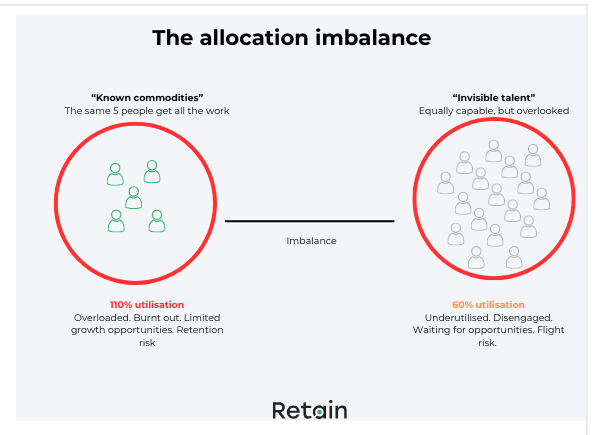A partner walks up needing someone who knows SEC reporting. The resource manager pulls up a few names, all of which are qualified and available. The partner shakes their head at every single one. "Just get me Sarah."
But Sarah's booked solid for the next eight weeks.
Andre Franklin from Linked Workforce sees this a lot. "Firms think it's a capacity issue," he told us. "It's not. They've got the people. They often just can't see them."
We asked Franklin why this keeps happening and why qualified people stay invisible even when they're sitting right there in the system. Turns out most firms are solving the wrong problem.
Signs you have a talent visibility problem (not a capacity problem)

Franklin calls this the "known commodity" problem versus the "invisible talent" problem. "These are the people who joined with a cohort, proved themselves early, and built a reputation for delivering," he explains. "Their visibility becomes a shortcut for resource decisions: they've done it before, they can do it again. They get booked up repeatedly, often without being asked."
Meanwhile, there's what Franklin describes as the "invisible talent". These are people who are equally capable, sometimes more so, but aren't connected to the people who control assignments. "They have potential, they're eager for stretch roles, and they're willing to learn. But they might not have that same visibility."
When these two dynamics collide there’s an imbalance. Known commodities become overloaded with work (not opportunities) which actually limits their growth. Invisible talent becomes underutilised and disengaged, limiting the organisation's growth. Both groups suffer. And the business pays the price. In fact, according to industry data, billable utilisation has fallen from 73.2% in 2021 to 68.9% in 2024.
You think you need to hire but the skills already exist internally
Similarly, partners often say "we need to hire." Maybe they do. Or maybe someone in the Lisbon office has exactly that expertise.
Franklin shared an example from a global logistics company that discovered a talented leader had been in their warehouse for over 12 years, completely unnoticed. Because the firm relied mostly on informal, word-of-mouth resource assignment, this employee's leadership strengths remained hidden in plain sight.
"It wasn't until a manager recognised his ability to influence others, his rapport across teams, and his deep organisational knowledge that his potential was fully seen," Franklin told us. Once given the opportunity, the employee excelled quickly. He was promoted into management and now plays a key role in developing future leaders across the organisation.
Twelve years. That's how long genuine capability can stay invisible when you're relying on memory and informal networks.
Geographic silos prevent cross-office resource allocation
We’ve mentioned this one briefly already, but it’s a really key point. Perhaps your Manchester team has brilliant people, but your London partners have no idea they exist. Everyone books locally because that's who they know, even when remote work is completely normal now.
Franklin's blunt about this: "The talent's there. The system could find them. But the data's incomplete or the process still runs on who you remember from the last project."
Geographic barriers persist because visibility often doesn't extend beyond local offices. The system could surface the right person regardless of location, but only if anyone's actually looking beyond their immediate circle.
Why resource planning systems may fail to improve visibility

Franklin says this pattern is everywhere. The talent exists. The system could find them. But something's blocking the connection between capability and opportunity.
It's rarely the technology itself that's failing. It's what happens, or doesn't happen, around it.
Skills data lives in the wrong places
The information exists somewhere. Someone's CV from three years ago. A performance review nobody can search. That one scheduler's head. Meanwhile, the resource management system sits empty or outdated because nobody's made it anyone's job to keep it current.
"If employees aren't entering or maintaining their skills profiles, it's usually because they don't believe it benefits them," Franklin explains. "People naturally invest time where they see a return."
He compares it to LinkedIn. We update those profiles because they offer tangible value. "Your internal tools tell the same story," Franklin says. "If no one is logging their skills, even while the organisation invests heavily in training, it's a strong signal that employees don't see meaningful visibility or opportunity tied to that data."
Of course, no system can surface talent if the data isn't there to begin with.
No clear ownership or governance of skills information
Even if skills get entered once, they rarely get updated. Someone finishes a massive regulatory project, develops serious expertise, yet often none of that makes it back into the system.
According to Franklin, effective skills data governance starts with clear ownership. "Organisations must designate data stewards, often a network of individuals, who understand the skills required to perform roles within their areas of expertise."
"Good governance also applies right-sized rigour," Franklin adds. "It solves the most urgent problems without over-engineering the process or creating unnecessary bureaucracy."
Without this governance structure, even sophisticated resource management tools become unreliable quickly.
People work around the system instead of using it
One of the biggest issues is when people work around the system. For instance, a partner emails the resource directly or a decision gets made in the Slack channel. But the resource management system never gets consulted, so it can't surface better options.
Franklin's blunt about the fix: "Make the system better than the workaround, and then bring the workaround into the system."
The tool has to deliver faster, higher-quality staffing outcomes than emailing someone you already know. "Resource managers and their institutional knowledge become part of how the tool matches and recommends talent. When the system reflects what actually works in the real world, people trust it, and they use it."
Some leaders prefer informal allocation over transparency
Another issue is that not everyone wants full transparency. If the system shows exactly who's available with what skills, partners can't claim certain people as "theirs."
Franklin describes the biggest mistake organisations make: "Failing to consider how new technology will reshape roles, responsibilities, and interactions across the team."
What happens when firms get resource visibility right

When firms commit to proper skills visibility, and Franklin's clear that means actual governance, the impact shows up quickly across multiple areas:
#1. You discover talent you didn't know you had
One firm found seven people with regulatory compliance skills scattered across different practice areas. They'd been hiring contractors for that work consistently. The expertise was already on payroll, but it was never documented properly.
Once they got it into their system, contractor spend dropped 40% in that specialty. The impact of improved utilisation is substantial. Research shows that just a 1% increase in utilisation can translate to a 20% boost in operating profit. When firms move from fragmented spreadsheets to proper resource management systems, average utilisation rates increase by 25 percentage points.
And that warehouse employee who spent 12 years invisible? Once his leadership capabilities were recognised and he was given opportunities, he quickly moved into management and now develops future leaders across the organisation.
"When firms commit to this properly, they discover they're talent-rich and visibility-poor," Franklin says. "That's a much better problem to solve than genuine skills shortages."
#2. Work gets distributed more fairly
When you can search by skill and availability together, the same three people don't get overbooked every quarter. High performers still get complex assignments, but junior people with relevant skills actually get chances to develop.
Known commodities stop getting overloaded with work that limits their growth. Invisible talent stops being underutilised and disengaged. Both groups benefit and so does the business.
#3. You know what skills you're actually missing
Proper visibility reveals where your gaps are. Maybe you genuinely need two more cybersecurity specialists. Maybe you've got adjacent skills that could be developed with targeted training.
Either way, you're making hiring and development decisions based on data instead of assumptions. Training investment becomes targeted instead of scattershot. Recruitment focuses on actual capability gaps.
#4. Geographic barriers dissolve
If you have a client in Birmingham who needs niche expertise, the system shows you've got someone in Edinburgh who's perfect and underutilised. Remote delivery works when you can actually find the right person regardless of location.
Cross-office collaboration stops being an aspiration and becomes standard practice, because visibility extends beyond local networks.
#5. Client delivery improves
Likewise, client delivery genuinely improves. When matching improves, project outcomes improve. Clients get people whose skills genuinely align with the work instead of generalists stretched beyond their expertise.
What it actually takes to get there

If you are ready to improve the value of resource management, here's what has to change:
The visibility checklist:
□ Designate clear data stewards with authority and time to own skills accuracy
□ Build skills updates into existing workflows (project closeouts, performance reviews, training completion)
□ Make the system mandatory for allocation decisions—no workarounds
□ Connect resource management to LMS, practice management, and HR systems
□ Track utilisation distribution as well as utilisation rates
□ Monitor skills-based search usage frequency
□ Measure time-to-fill for resource requests
□ Review and update skills data quarterly at minimum
□ Show employees how maintaining their profiles benefits them directly
□ Make the system faster and better than emailing someone you know
□ Operationalise relationships by bringing institutional knowledge into the tool
□ Apply right-sized governance that solves urgent problems without bureaucracy
Franklin's clear on the bottom line: if people aren't using the system, it's because they don't see the value. "People naturally invest time where they see a return." Your job is to make that return visible and immediate.
Working in partnership with resource management systems
Resource management software delivers value. Firms see better visibility, faster scheduling, improved utilisation. But the firms that see the biggest transformation are doing something beyond implementing technology.
As Franklin puts it; "The difference is how they view the tool. Organisations that truly transform see technology as a catalyst, not the solution."
The key point here is that there's a ceiling to what technology alone can achieve if the underlying processes and behaviours stay unchanged.
"Transformation requires rethinking how resource planning actually works," Franklin explains. "Standardising processes. Integrating the right data. Defining rules for exceptions. Aligning decision-making across teams."
The act of making those decisions is what creates the transformation in real time. People who engage in that journey become part of the new, improved organisation.
Then comes the second phase: helping everyone else transition from the old norms to the new way of operating.
When you can truly see your talent including the skills, capacity, location, and development trajectory everything improves. Utilisation balances out. Allocation becomes fairer. Planning becomes strategic. People stay longer.
Want to see how firms are using Retain to unlock better talent visibility? Book a demo


